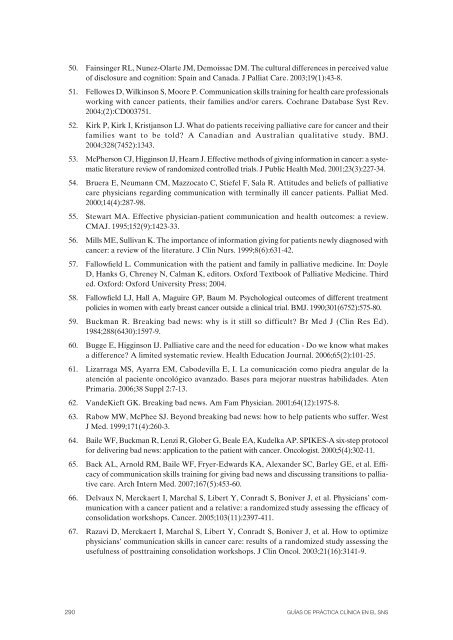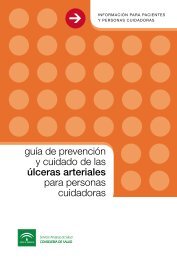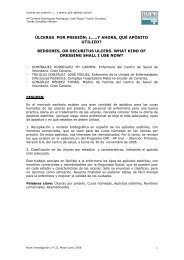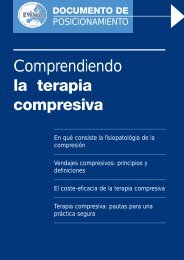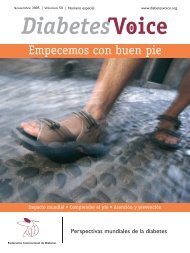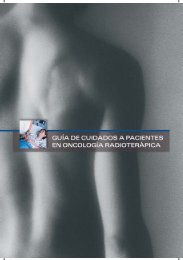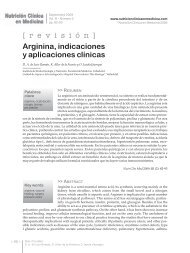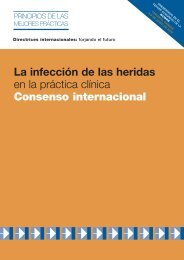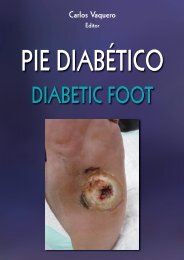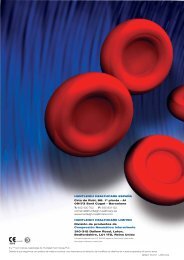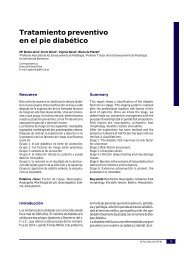34. Vigano A, Dorgan M, Buckingham J, Bruera E, Suarez-Almazor ME. Survival prediction interminal cancer patients: A systematic review of the medical literature. Palliative Medicine.2000;14(5):363-74.35. Maltoni M, Nanni O, Pirovano M, Scarpi E, In<strong>de</strong>lli M, Martini C, et al. Successful Validationof the Palliative Prognostic Score in Terminally Ill Cancer Patients. Journal of Pain andSymptom Management. 1999;17(4):240-7.36. Pirovano M, Maltoni M, Nanni O, Marinari M, In<strong>de</strong>lli M, Zaninetta G, et al. A new palliativeprognostic score: a first step for the staging of terminally ill cancer patients. Italian Multicenterand Study Group on Palliative Care. J Pain Symptom Manage. 1999;17(4):231-9.37. Morita T, Tsunoda J, Inoue S, Chihara S. The Palliative Prognostic In<strong>de</strong>x: a scoring system forsurvival prediction of terminally ill cancer patients. Support Care Cancer. 1999;7(3):128-33.38. Coventry PA, Gran<strong>de</strong> GE, Richards DA, Todd CJ. Prediction of appropriate timing of palliativecare for ol<strong>de</strong>r adults with non-malignant life-threatening disease: A systematic review.Age & Ageing. 2005;34(3):218-27.39. Walter LC, Brand RJ, Counsell SR, Palmer RM, Lan<strong>de</strong>feld CS, Fortinsky RH, et al. Developmentand Validation of a Prognostic In<strong>de</strong>x for 1-Year Mortality in Ol<strong>de</strong>r Adults AfterHospitalization. JAMA. 2001;285(23):2987-94.40. Katz S, Ford A, Moskowitz RW, Jackson B, Jaffe M. Studies of illness in the aged. the in<strong>de</strong>x ofADL: a standardized measure of biological and psychosocial function. JAMA. 1963;185:914-9.41. Charlson ME, Pompei P, Ales KL, MacKenzie CR. A new method of classifying prognosticcomorbidity in longitudinal studies: Development and validation. Journal of Chronic Diseases.1987;40(5):373-83.42. Fischer SM, Gozansky WS, Sauaia A, Min SJ, Kutner JS, Kramer A. A practical tool to i<strong>de</strong>ntifypatients who may benefit from a palliative approach: the CARING criteria. J Pain SymptomManage. 2006;31(4)285-92.43. Knaus WA, Harrell FE, Lynn J, Goldman L, Phillips RS, Connors AF, et al. The SUPPORTPrognostic Mo<strong>de</strong>l: Objective Estimates of Survival for Seriously Ill Hospitalized Adults. AnnIntern Med. 1995;122(3):191-203.44. Stuart B, Alexan<strong>de</strong>r C, Arenella C. Medical gui<strong>de</strong>lines for <strong>de</strong>termining prognosis in selectednon-cancer diseases, 2nd edition. Arlington,VA: National Hospice Organization; 1996.45. Celli BR, Cote CG, Marin JM, Casanova C, Montes <strong>de</strong> Oca M, Men<strong>de</strong>z RA, et al. The Body-Mass In<strong>de</strong>x, Airflow Obstruction, Dyspnea, and Exercise Capacity In<strong>de</strong>x in Chronic ObstructivePulmonary Disease. N Engl J Med. 2004;350(10):1005-12.46. Levy WC, Mozaffarian D, Linker DT, Sutradhar SC, Anker SD, Cropp AB, et al. The SeattleHeart Failure Mo<strong>de</strong>l: Prediction of Survival in Heart Failure. Circulation. 2006;113(11):1424-33.47. Kamath PS, Wiesner RH, Malinchoc M, Kremers W, Therneau TM, Kosberg CL, et al. A mo<strong>de</strong>lto predict survival in patients with end-stage liver disease. Hepatology. 2001;33(2):464-70.48. Glare PA, Eychmueller S, McMahon P. Diagnostic Accuracy of the Palliative Prognostic Scorein Hospitalized Patients With Advanced Cancer. J Clin Oncol. 2004;22(23):4823-8.49. Parker SM, Clayton JM, Hancock K, Wal<strong>de</strong>r S, Butow PN, Carrick S, et al. A SystematicReview of Prognostic/End-of-Life Communication with Adults in the Advanced Stages of aLife-Limiting Illness: Patient/Caregiver Preferences for the Content, Style, and Timing ofInformation. Journal of Pain and Symptom Management. 2007;34(1):81-93.GUÍA DE PRÁCTICA CLÍNICA SOBRE CUIDADOS PALIATIVOS 289
50. Fainsinger RL, Nunez-Olarte JM, Demoissac DM. The cultural differences in perceived valueof disclosure and cognition: Spain and Canada. J Palliat Care. 2003;19(1):43-8.51. Fellowes D, Wilkinson S, Moore P. Communication skills training for health care professionalsworking with cancer patients, their families and/or carers. Cochrane Database Syst Rev.2004;(2):CD003751.52. Kirk P, Kirk I, Kristjanson LJ. What do patients receiving palliative care for cancer and theirfamilies want to be told? A Canadian and Australian qualitative study. BMJ.2004;328(7452):1343.53. McPherson CJ, Higginson IJ, Hearn J. Effective methods of giving information in cancer: a systematicliterature review of randomized controlled trials. J Public Health Med. 2001;23(3):227-34.54. Bruera E, Neumann CM, Mazzocato C, Stiefel F, Sala R. Attitu<strong>de</strong>s and beliefs of palliativecare physicians regarding communication with terminally ill cancer patients. Palliat Med.2000;14(4):287-98.55. Stewart MA. Effective physician-patient communication and health outcomes: a review.CMAJ. 1995;152(9):1423-33.56. Mills ME, Sullivan K. The importance of information giving for patients newly diagnosed withcancer: a review of the literature. J Clin Nurs. 1999;8(6):631-42.57. Fallowfield L. Communication with the patient and family in palliative medicine. In: DoyleD, Hanks G, Chreney N, Calman K, editors. Oxford Textbook of Palliative Medicine. Thir<strong>de</strong>d. Oxford: Oxford University Press; 2004.58. Fallowfield LJ, Hall A, Maguire GP, Baum M. Psychological outcomes of different treatmentpolicies in women with early breast cancer outsi<strong>de</strong> a clinical trial. BMJ. 1990;301(6752):575-80.59. Buckman R. Breaking bad news: why is it still so difficult? Br Med J (Clin Res Ed).1984;288(6430):1597-9.60. Bugge E, Higginson IJ. Palliative care and the need for education - Do we know what makesa difference? A limited systematic review. Health Education Journal. 2006;65(2):101-25.61. Lizarraga MS, Ayarra EM, Cabo<strong>de</strong>villa E, I. La comunicación como piedra angular <strong>de</strong> laatención al paciente oncológico avanzado. Bases para mejorar nuestras habilida<strong>de</strong>s. AtenPrimaria. 2006;38 Suppl 2:7-13.62. Van<strong>de</strong>Kieft GK. Breaking bad news. Am Fam Physician. 2001;64(12):1975-8.63. Rabow MW, McPhee SJ. Beyond breaking bad news: how to help patients who suffer. WestJ Med. 1999;171(4):260-3.64. Baile WF, Buckman R, Lenzi R, Glober G, Beale EA, Ku<strong>de</strong>lka AP. SPIKES-A six-step protocolfor <strong>de</strong>livering bad news: application to the patient with cancer. Oncologist. 2000;5(4):302-11.65. Back AL, Arnold RM, Baile WF, Fryer-Edwards KA, Alexan<strong>de</strong>r SC, Barley GE, et al. Efficacyof communication skills training for giving bad news and discussing transitions to palliativecare. Arch Intern Med. 2007;167(5):453-60.66. Delvaux N, Merckaert I, Marchal S, Libert Y, Conradt S, Boniver J, et al. Physicians’ communicationwith a cancer patient and a relative: a randomized study assessing the efficacy ofconsolidation workshops. Cancer. 2005;103(11):2397-411.67. Razavi D, Merckaert I, Marchal S, Libert Y, Conradt S, Boniver J, et al. How to optimizephysicians’ communication skills in cancer care: results of a randomized study assessing theusefulness of posttraining consolidation workshops. J Clin Oncol. 2003;21(16):3141-9.290 GUÍAS DE PRÁCTICA CLÍNICA EN EL SNS
- Page 2 and 3:
Guía de Práctica Clínicasobre Cu
- Page 6 and 7:
6.2. Tratamiento del dolor 816.2.1.
- Page 8 and 9:
Anexo 4. Aspectos legales en cuidad
- Page 10 and 11:
ta para mejorar la atención y cons
- Page 12 and 13:
Maria José Arrizabalaga Arrizabalo
- Page 14 and 15:
Preguntas para responderIntroducci
- Page 16 and 17:
Cuidados de la piel36. ¿Cuál es l
- Page 18 and 19:
Resumen de las recomendacionesIntro
- Page 20 and 21:
DDSe recomienda informar al equipo
- Page 22 and 23:
DeshidrataciónDDBD√La vía oral
- Page 24 and 25:
InsomnioDDDDDLa valoración de un p
- Page 26 and 27:
AEn los pacientes oncológicos con
- Page 28 and 29:
C√El tratamiento médico de la ob
- Page 30 and 31:
DDPuede utilizarse calcitonina de s
- Page 32 and 33:
DEs importante considerar las difer
- Page 34 and 35:
BDBBDNo se recomiendan las interven
- Page 36 and 37:
• La necesidad de que el equipo s
- Page 38 and 39:
3. MetodologíaMetodología. Nivele
- Page 40 and 41:
• La revisión se ha realizado so
- Page 42 and 43:
Así, la transición de los cuidado
- Page 44 and 45:
Los elementos interrelacionados del
- Page 46 and 47:
Además, en un corto periodo de tie
- Page 48 and 49:
Nivel básicoEl nivel básico deber
- Page 50 and 51:
Con el objetivo de mejorar la preci
- Page 52 and 53:
asa en criterios sencillos de obten
- Page 54 and 55:
C√√En enfermos no oncológicos,
- Page 56 and 57:
en lo que se refiere a la propia en
- Page 58 and 59:
capacidad de adaptación de los pac
- Page 60 and 61:
decisiones (69). Por otra parte, el
- Page 62 and 63:
comprendido lo que se le ha explica
- Page 64 and 65:
• Los deseos de los representante
- Page 66 and 67:
2+ La comunicación eficaz influye
- Page 68 and 69:
6. Control de síntomas6.1. Introdu
- Page 70 and 71:
Los síntomas son cambiantes en el
- Page 72 and 73:
• Valorar las opciones de tratami
- Page 74 and 75:
RecomendacionesDDDDLa valoración d
- Page 76 and 77:
Tabla 3. Principios generales para
- Page 78 and 79:
subcutánea y de los adyuvantes, y
- Page 80 and 81:
Figura 7. Algoritmo de tratamiento
- Page 82 and 83:
La familiaridad del clínico con lo
- Page 84 and 85:
Ketamina es una anestésico general
- Page 86 and 87:
6.2.7. Dolor óseo metastásicoEl d
- Page 88 and 89:
cáncer de mama y de pulmón con m
- Page 90 and 91:
DCDDABBBDBBBEl equipo de profesiona
- Page 92 and 93:
Tabla 7. Factores relacionados con
- Page 94 and 95:
Resumen de evidencia1+ El ejercicio
- Page 96 and 97:
administrar de forma continua duran
- Page 98 and 99:
correlación entre hipoxia y disnea
- Page 100 and 101:
No se encontraron estudios con cort
- Page 102 and 103:
DBABDSe recomienda valorar la inten
- Page 104 and 105:
En caso de tos resistente a los dif
- Page 106 and 107:
la radioterapia y los stents con un
- Page 108 and 109:
Tabla 14. Confusion Assessment Meth
- Page 110 and 111:
En los casos de delirium con agitac
- Page 112 and 113:
El insomnio puede aparecer como ref
- Page 114 and 115:
el tratamiento multifactorial (estr
- Page 116 and 117:
nes), una red social de apoyo pobre
- Page 118 and 119:
6.5.4. DepresiónLa depresión es h
- Page 120 and 121:
• Complicaciones endocrino-metab
- Page 122 and 123:
Los pensamientos de suicidio son mu
- Page 124 and 125:
BDEn caso necesario pueden usarse f
- Page 126 and 127:
La calidad de los ECA fue muy varia
- Page 128 and 129:
6.6.3. Boca seca (xerostomía)La xe
- Page 130 and 131:
Existe consistencia sobre la eficac
- Page 132 and 133:
AEn los pacientes oncológicos con
- Page 134 and 135:
los excluye. Es mucho más abundant
- Page 136 and 137:
Figura 11. Profilaxis y tratamiento
- Page 138 and 139:
DBBDBBEn los pacientes que reciben
- Page 140 and 141:
BDLa prescripción de opioides debe
- Page 142 and 143:
Resumen de evidencia1+ Loperamida e
- Page 144 and 145:
Tabla 24. Resultados (% y rango) de
- Page 146 and 147:
• Diuréticos: un ensayo abierto,
- Page 148 and 149:
Resumen de evidencia3 Los pacientes
- Page 150 and 151:
• Proporciona un ambiente húmedo
- Page 152 and 153:
ejemplo, en la colestasis existe un
- Page 154 and 155:
RecomendacionesDDDEl manejo inicial
- Page 156 and 157:
6.9. UrgenciasLas preguntas que se
- Page 158 and 159:
días, sin que se observaran difere
- Page 160 and 161:
metástasis óseas, la duración su
- Page 162 and 163:
CBDBEl tratamiento debe llevarse a
- Page 164 and 165:
La elección de un fármaco tiene q
- Page 166 and 167:
En la tabla 34 se muestran las medi
- Page 168 and 169:
7. Apoyo psicosocial y espiritual a
- Page 170 and 171:
7.1.2. Intervenciones psicosociales
- Page 172 and 173:
1+/2+ En pacientes con cáncer en d
- Page 174 and 175:
(312). El instrumento adecuado son
- Page 176 and 177:
3 No existe unanimidad respecto a l
- Page 178 and 179:
mayor parte de la responsabilidad y
- Page 180 and 181:
• Incorporar a los cuidadores a l
- Page 182 and 183:
Algunos de estos aspectos pueden no
- Page 184 and 185:
• Suspender todas las pruebas e i
- Page 186 and 187:
La dosis habitual de butilescopolam
- Page 188 and 189:
• El consentimiento explícito de
- Page 190 and 191:
• Situación del enfermo: situaci
- Page 192 and 193:
Tras iniciar el tratamiento farmaco
- Page 194 and 195:
RecomendacionesDDDLGDDEl proceso de
- Page 196 and 197:
En el duelo se pueden presentar una
- Page 198 and 199:
• Enfermedad excesivamente corta
- Page 200 and 201:
Para diagnosticar el duelo complica
- Page 202 and 203:
La revisión de Wimpenny et al. (33
- Page 204 and 205:
Anexos
- Page 206 and 207:
Anexo 2. EscalasEscala Edmonton Sym
- Page 208 and 209:
EscalaValoración funcional100 Norm
- Page 210 and 211:
Actividades de la vida diariaComer:
- Page 212 and 213:
Escala de los Cuidados Paliativos (
- Page 214 and 215:
La Escala visual analógica de inte
- Page 216 and 217:
Escala de RamsayNivel INivel IINive
- Page 218 and 219:
• Características del paciente:
- Page 220 and 221:
esta fase. Como elementos important
- Page 222 and 223:
Eutanasia y suicidio asistidoEn rel
- Page 224 and 225:
Anexo 5. VademécumVademécum por s
- Page 226 and 227:
Síntoma Fármaco Dosis recomendada
- Page 228 and 229: Síntoma Fármaco Dosis recomendada
- Page 230 and 231: Síntoma Fármaco Dosis recomendada
- Page 232 and 233: Síntoma Fármaco Dosis recomendada
- Page 234 and 235: Síntoma Fármaco Dosis recomendada
- Page 236 and 237: Síntoma Fármaco Dosis recomendada
- Page 238 and 239: Síntoma Fármaco Dosis recomendada
- Page 240 and 241: Síntoma Fármaco Dosis recomendada
- Page 242 and 243: Vademécum por principio activoFár
- Page 244 and 245: FármacoNombrecomercial**Presentaci
- Page 246 and 247: FármacoNombrecomercial**Presentaci
- Page 248 and 249: FármacoNombrecomercial**Presentaci
- Page 250 and 251: FármacoNombrecomercial**Presentaci
- Page 252 and 253: FármacoNombrecomercial**Presentaci
- Page 254 and 255: FármacoNombrecomercial**Presentaci
- Page 256 and 257: FármacoNombrecomercial**Presentaci
- Page 258 and 259: FármacoNombrecomercial**Presentaci
- Page 260 and 261: FármacoNombrecomercial**Presentaci
- Page 262 and 263: Figura 1. Zonas de punción recomen
- Page 264 and 265: Compatibilidad de mezclas• En nue
- Page 266 and 267: Dosificación con fentanilo transd
- Page 268 and 269: Dosificación con buprenofina trans
- Page 270 and 271: Estudio Transversal-Descriptivo: Es
- Page 272 and 273: SIGN: Agencia escocesa mutidiscipli
- Page 274 and 275: HADSIASPICCICSIIECAIMIMCINRIPISR NI
- Page 276 and 277: Bibliografía1. Estrategia en Cuida
- Page 280 and 281: 68. Barbero J. El derecho del pacie
- Page 282 and 283: 104. McNicol E, Horowicz-Mehler N,
- Page 284 and 285: 141. Sweeney C, Neuenschwnader H, B
- Page 286 and 287: 176. Moroni M, Porta C, Gualtieri G
- Page 288 and 289: 211. Assessment, Evaluation, and Ma
- Page 290 and 291: 242. Cancer care Ontario Practice G
- Page 292 and 293: 275. Khurana S, Singh P. Rifampin i
- Page 294 and 295: 310. Holloway M. Death the great le
- Page 296 and 297: 345. Kristjanson L, Lobb E, Aoun S.


